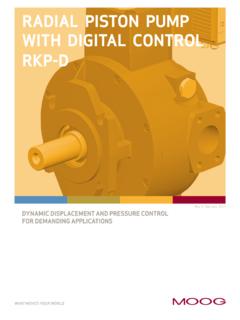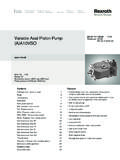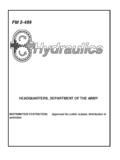Transcription of Figure 1 Quickand Easy Guide - Eaton
1 Reprinted from Design World for Eaton Corp., 2011 WTWH Media, Power ||||Rodney B. EricksonSenior Training SpecialistEaton gear, piston and vane pumps, one type is not better than any other type in an absolute sense they simply are different, with individual Hydraulic Pump Technology and SelectionandAEasy GuideFigure 1 The hydraulic pumps found in virtually all mobile and industrial applications today use pistons, vanes, or gears to create the pumping action that produces flow. Each method features individual characteristics that differentiate it from the others and make it suitable for a particular range of applications.
2 piston pumpsPiston pumps can have the pistons arranged in a radial or axial fashion. Radial types tend to be specialized for applications requiring very high power, while axial piston pumps are available in a wide range of displacements and pressure capabilities that make them suitable for many mobile and industrial tasks. Axial- piston pumps consist of a set of pistons that are fitted within a cylinder block and driven by an angled swash plate powered by the input shaft. As the swash plate rotates, the pistons reciprocate in their respective cylinder block bores to provide the pumping action.
3 ( Figure 1 above) Axial- piston pumps are available with the input shaft and pistons arranged coaxially, or with the input shaft mounted at an angle to the piston bores. Bent axis pumps tend to be slightly more volumetrically efficient for technical reasons, but they also tend to be slightly larger for a given capacity and their shape can present packaging difficulties in some applications. A unique characteristic of a piston -type pump is that the displacement can be changed simply by changing the angle of the swash plate.
4 Any Figure 2 Fluid Power ||||displacement between zero and maximum is easily achieved with relatively simple actuators to change the swash plate pumpsThe most commonly encountered vane-type pump generates flow using a set of vanes, which are free to move radially within a slotted rotor that rotates in an elliptical chamber. A typical configuration uses an elliptical cam ring with the rotor spinning within in a cylindrical housing and a pair of side plates to form the pumping chambers. ( Figure 2) The changing volume of the cavity between adjacent vanes creates the pumping action as the rotor rotates.
5 It is possible to vary the displacement of a vane-type pump, but this is not commonly done except for very specialized applications. The majority of the vane-type pumps used in industrial and mobile applications have a fixed displacement. Vane pumps can be hydraulically balanced, which greatly enhances efficiency. Some designs place the rotating group in a cartridge, which makes them very easy to repair. The entire rotating group is easily removed and replaced by simply removing the back cover, pulling out the old rotating cartridge and replacing it with a new one.
6 Vane-type pumps are known for being very quiet in operation and producing very little pumps The simplest gear-type pump uses a pair of mating gears rotating in an oval chamber to produce flow. As the gears rotate, the changing size of the chambers created by the meshing and unmeshing of the teeth provides the pumping action. ( Figure 3) Another design uses an external rotating ring with internal gear teeth that mesh with an internal gear as it rotates. As the inner gear rotates, the tooth engagement creates chambers of diminishing size between the inlet and outlet positions to create flow.
7 A more sophisticated variant of this principle is the gerotor pump, which has a non-concentric inner and outer rotor with different numbers of teeth. As the pair rotates, the changing volume of the space between the rotors creates the pumping action. Replacing the meshing teeth of the gerotor pump with low-friction rolling elements produces a geroter pump. All gear-type pumps have a fixed displacement. These pumps are relatively inexpensive compared to piston and vane type pumps with similar displacements, but tend to wear out more quickly Figure 3 Reprinted from Design World for Eaton Corp.
8 , 2011 WTWH Media, are not generally economically spotsPiston-type pumps have a very good service life, provided contamination and heat are controlled. They also have the highest pressure ratings, and the significant advantage of variable displacement. This makes them the best choice for applications where high efficiency and high power density are important considerations. The ability to configure Fluid Power ||||Comparing pumpsPressurePiston pumps have the highest pressure capabilities of the three technologies, up to 7250 psi (500 bar) for those in common use, and as high at 10,000 psi (690 bar) for certain specialized units.
9 Vane and gear pumps are commonly limited to pressures up to about 4000 psi (275 bar).Input Speed piston pumps have the highest input speed DensityHydraulic power density is directly related to operating pressure; the higher the pressure the greater the power density. piston pumps offer the highest power density with vane and gear types following in that EfficiencyLike power density, the conversion ratio of input power to output power is directly related to operating pressure. piston pumps offer the highest conversion ratio, followed by vane and gear pumps in that order.
10 The ability of piston and vane pumps to be hydraulically balanced is also a factor in their greater conversion ToleranceNo hydraulic component is immune to damage from dirt! But of the three pump technologies, the gear-type is the most dirt tolerant, followed by vane and piston pumps in that Vacuum TolerancePositive inlet pressure is always preferred in hydraulic pump applications to avoid wear and premature failure. However, of the three technologies, gear-type pumps are the most vacuum tolerant handling vacuums up to 10 (254 mm-Hg).















